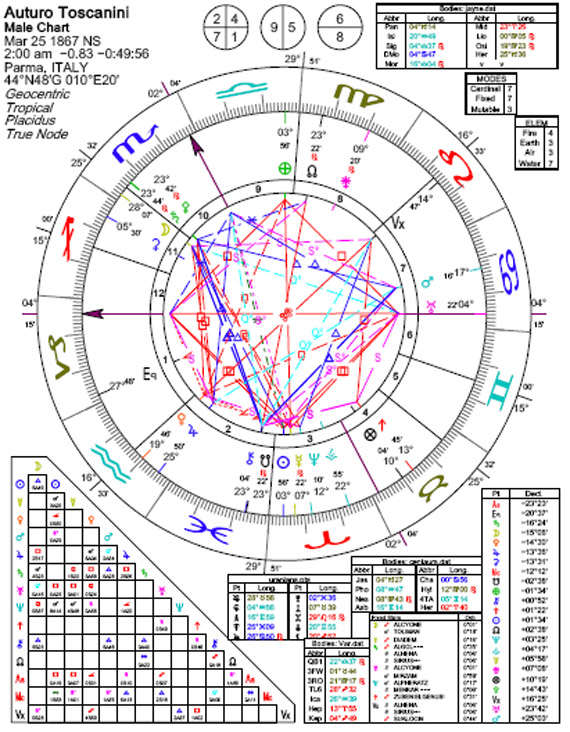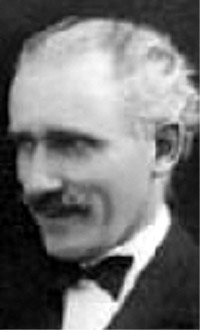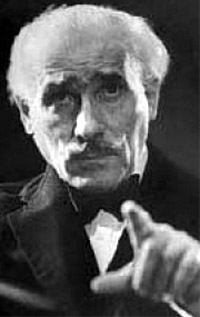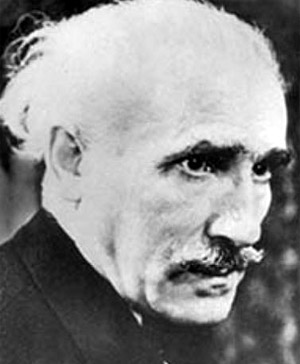Auturo Toscanini
Copyright Michael D. Robbins 2005
Astro-Rayological Interpretation & Charts
Quotes
Biography
Images and Physiognomic Interpretation
Arturo Toscanini—Orchestral Conductor
March 25, 1867, Parma, Italy, 2:00 AM, LMT. (Source: Lois Rodden cites the Church of Light which reports, “data from him personally”) Died, January 15, 1957.
(Ascendant, Capricorn; MC, Scorpio; Sun, Aries conjunct Mercury and Neptune (widely), both in Aries; Moon conjunct Saturn in Scorpio; Venus conjunct Jupiter in Aquarius; Mars in Cancer and Uranus also in Cancer conjunct DSC; Pluto in Taurus; NN in Virgo )
Arturo Toscanini is considered by many to be the greatest orchestral conductor of his day, and by some, simply the greatest of all orchestra conductors. He was the leader of some of the finest symphony orchestras and opera companies throughout the world, including the NBC Symphony Orchestra. He was known for his brilliant memory (conducting all major works from memory) his infallible ear, his superb musicianship, his intense passion and for the great demands he placed upon all performers—orchestral members and singers alike.
The fourth and first rays are strong in Toscanini as is the passionate sixth and the meticulous seventh. Perhaps the fourth ray was his soul ray and the first ray (greatly stimulated by the sixth), the ray of his personality, with the sixth ray (greatly reinforced) in his chart, ruling his astral nature,and the seventh ray his etheric-physical nature.
Anecdotes in relation to Toscanini abound. (See videos of great conductors) One need not listen too carefully to his recordings (operatic, choral and even orchestral) to hear his voice singing and passionately during powerful musical climaxes—an accompaniment
which his fans grew to love. Stories of his temper and dramatic outbursts are plentiful and proverbial. He was not one to be taken lightly or trifled with. Once when conducting a renowned (and proud) German orchestra (the members of which had nothing but contempt for any “Italian” conductor), some of the leading instrumentalists thought they would play a joke on their new conductor and thus subtly demonstrate his inferiority and their disrespect. During the beginning of the rehearsal, they deliberately, continuously and subtly, played wrong notes in various places. Toscanini did not stop them and simply conducted the piece through. The instrumentalists were satisfied that they had proved the worthlessness of their new conductor and sat there smugly. Toscanini paused and thanked them for their performance, and then said there were a few things to which he would like to call their attention. He then proceeded to name every single mistake in every instrument—all the way through the section which had just been played—an amazing feet of discernment and memory. The orchestra was appalled, shamed and chastened. Toscanini had gained their lasting respect (Ascendant, Capricorn, the master of this field).
Never, perhaps, was there an orchestral conductor more musically demanding, more respected, more revered. Upon his death, the NBC Symphony of the Air, of which he was the conductor, gave a farewell performance without conductor—simply imagining that he was still there. So powerful was the impression he bequeathed, that, indeed, it was as if he stood before the orchestra—which played brilliantly. With his Jupiter/Venus conjunction in Aquarius, he had infused them with such a sense of group soul (both Jupiter and Venus being second ray planets of the soul) that they were “as one” and could play “as one” under his lasting impression.
Musical inspiration flowed to Toscanini through his Mercury/Neptune conjunction in Aries. Mercury is the esoteric ruler of the Aries Sun and retrograde. So many outstanding and original people seem to have this retrograde Mercury. His sense of form was impeccable—Capricorn is rising with its exoteric and esoteric ruler, Saturn, in Scorpio conjunct the Moon also in Scorpio, making of him an intense disciplinarian—exacting to the point of exhaustion. Yet, always, the discipline was worth the pressure. ?e musical groups which he inspired (Jupiter conjunct Venus in Aquarius) simply had to endure the pressure on the form (Saturn/Moon) which was exacting, thorough and missed no error. One can see Venus on the short let of a TR-Square, square ?rst ray Saturn and first ray Pluto which oppose each other.
Was Toscanini emotional? Clearly so—almost violently so. The exoteric ruler of his already incendiary Aries Sun is sixth ray Mars in the emotional, solar-plexus-stimulating sign, Cancer. And this Mars is square another sixth ray planet, Neptune, found in Aries, so there is a kind of mutual reception between Mars and Neptune. One can see that it was easy for Toscanini to get “carried away”—but never for long, before the great classicism and restraint of which he was capable took over. It is signi?cant to see the esoteric ruler of the Ascendant, Saturn, trine to the exoteric ruler of the Aries Sun, Mars. Thus we see another example of how emotion (Mars) was disciplined for the sake of art—the more spiritually important ruler, Saturn, subduing without much difficulty the less important ruler, Mars.
One more point (of many possible points) deserves mention—Uranus in Cancer on the cusp on the seventh house. Uranus is the great transformer, and it is found at the point where the other is met—whether that other is an individual or a group of individuals. Further this Uranus is square his Sun, Mercury and Neptune in Aries. Meeting Toscanini, and working with Toscanini, must have brought major transformations to many individuals and group. Here was an electric individual, filled with an intense passion for music, and yet a consummate artist and craftsman. It is clear that Arturo Toscanini was a life-changer, and an awakener—both the qualities of Uranus. One feels the first ray coming through this planet, in his case, even more than the seventh.
The fourth ray has been called the “Corrector of the Form”, and Toscanini fulfilled this concept in an exemplary manner. Was he a fourth ray soul—ahead of his time? Or was he, spiritually, upon the passionate sixth ray? The sixth ray somehow seems more instrumental, as does the first (unless it resides at a very deep level). Certainly, his legacy is in the realm of the fourth ray, having given a number of definitive performances which few can equal and none have surpassed. His boundless and ferocious energy is strengthened by Aries, his Sun Sign. His demanding perfectionism is a gift of his Capricorn Ascendant, as is his impeccable sense of musical structure. His depth and intensity are augmented by his Scorpio Moon conjunct the task-master, Saturn.
One realizes that he (whether in this life or others) has suffered greatly, and is offering the fruit of that suffering as beauty. One can see in these several factors many conduits for the first ray as well. The fourth ray can and reinforcement via that Scorpio planets (fourth ray Moon and Saturn) and via the Taurus Pluto. Buddhi, fourth ray Mercury conjoining Neptune reinforce fourth ray potentials. The Mars/Neptune mutual reception is a conduit for the sixth ray energy.
It is difficult to “talk” about the performances which Toscanini conducted. It is far better simply to listen to them (old though they may be, in terms of recording technology)—listen—be thrilled and be changed.
I kissed my first girl and smoked my first cigarette on the same day. I haven't had time for tobacco since.
(Moon in Scorpio)God tells me how the music should sound, but you stand in the way.
To a trumpet player, NY Times 11 Apr 54
(Uranus conjunct Descendant in Cancer. Mars in Cancer in 7th house.)After I die I shall return to earth as the doorkeeper of a bordello and I won’t let a one of you in.
ATTRIBUTION: To an orchestra that displeased him, recalled on his death 16 Jan 57
(Moon in Scorpio conjunct Saturn)Routine is the death of music.
(Capricorn Ascendant?)Of Richard Strauss, whose political behavior during World War II was arguably very questionable:
"To Strauss the composer I take off my hat; to Strauss the man I put it back on again.""The conduct of my life has been, is, and will always be the echo and reflection of my conscience."
"Gentlemen, be democrats in life but aristocrats in art."
Toscanini was born in Parma, Emilia-Romagna, Italy and won a scholarship to the local music conservatory, where he studied cello. He joined the orchestra of an opera company, with which he toured South America in 1886. While presenting Aida in Rio de Janeiro, the orchestra's conductor was booed by the audience and forced to leave the podium. Although he had no conducting experience, Toscanini was persuaded to take up the baton, and led a magnificent performance completely from memory. Thus began his career as a conductor at age 19.
Upon returning to Italy, Toscanini self-effacingly returned to his chair in the cello section, and participated as cellist in the world premiere of Verdi's Otello (La Scala, 1887) under the composer's supervision. (Verdi, who habitually complained that conductors never seemed interested in directing his scores the way he had written them, was impressed by reports from Arrigo Boito about Toscanini's ability to interpret his scores. The composer was also impressed when Toscanini consulted him personally, indicating a ritardando where it was not set out in the score and saying that only a true musician would have felt the need to make that ritardando.)
Gradually the young musician's reputation as an operatic conductor of unusual authority and skill supplanted his cello career. In the following decade he consolidated his career in Italy, entrusted with the world premieres of Puccini's La Bohème and Leoncavallo's Pagliacci. In 1896 he conducted his first symphonic concert (works by Schubert, Brahms, Tchaikovsky, and Wagner), in Turin. By 1898 he was resident conductor at La Scala, Milan and remained there until 1908, returning during the 1920s. He took the Scala Orchestra to the United States on a concert tour in 1920-21; it was during that tour that Toscanini made his first recordings.
One of Toscanini's first recordings
International recognition
Outside of Europe, he conducted at the Metropolitan Opera in New York (1908–1915) as well as the New York Philharmonic Orchestra (1926–1936). He toured Europe with the New York Philharmonic in 1930; he and the musicians were acclaimed by critics and audiences wherever they went. As was also the case with the New York Philharmonic, Toscanini was the first non-German conductor to appear at Bayreuth (1930–1931). In the 1930s he conducted at the Salzburg Festival (1934–1937) and the inaugural concert in 1936 of the Palestine Symphony Orchestra (now the Israel Philharmonic Orchestra) in Tel Aviv, and later performed with them in Jerusalem, Haifa, Cairo and Alexandria.
The NBC Symphony Orchestra
Strongly opposed to Italian fascism and German nazism, he left Europe for the United States where the NBC Symphony Orchestra was created for him in 1937. He conducted the first broadcast concert on December 25, 1937, in NBC Studio 8-H in New York City's Rockefeller Center. The acoustics were very dry, until some remodeling in 1939 added a bit more reverberation to the studio. (In 1950, the studio was further remodeled for television productions; today it is used by NBC for Saturday Night Live. In 1980, it was used by Zubin Mehta and the New York Philharmonic Orchestra in a special televised NBC concert honoring the legacy of Toscanini.)Toscanini was often criticized for neglecting American music; however, in 1938, he conducted the world premieres of two orchestral works by Samuel Barber, Adagio for Strings and Essay for Orchestra. In 1945, he led the orchestra in Carnegie Hall recording sessions of the Grand Canyon Suite by Ferde Grofe and An American in Paris by George Gershwin. He also conducted broadcast performances of Copland's El Salon Mexico and Gershwin's Rhapsody in Blue with soloists Earl Wild and Benny Goodman and Concerto in F with pianist Oscar Levant, as well as music by other American composers, including two marches of John Philip Sousa.
In 1940, Toscanini took the orchestra on a "goodwill" tour of South America. Later that year, Toscanini had a disagreement with NBC management over their use of his musicians in other NBC broadcasts; Toscanini threatened to move to CBS, until the dispute was resolved and he returned as music director. At that time Leopold Stokowski began conducting some of the concerts and continued to appear periodically as a guest conductor of the orchestra.
One of the more remarkable broadcasts was in July 1942, when Toscanini conducted the American premiere of Dmitri Shostakovich's Symphony No. 7. Due to World War II, the score was microfilmed in the Soviet Union and brought by courier to the United States. Stokowski wanted to conduct the premiere and there were a number of remarkable letters between the two conductors (reproduced by Harvey Sachs in his biography) before Stokowski agreed to let Toscanini have the privilege of conducting the first performance. Unfortunately for New York listeners, a major thunderstorm virtually obliterated the NBC radio signals there, but the performance was heard elsewhere and preserved on transcription discs. It was later issued by RCA Victor during the 1967 centennial boxed set tribute to Toscanini, which included a number of NBC broadcasts never released on discs.[1]
In 1943, he appeared in a documentary film for the Office of War Information (OWI) directed by Alexander Hammid, Hymn of the Nations, which featured Toscanini conducting the NBC Symphony Orchestra performing the music of Verdi. Filmed in NBC Studio 8-H, the orchestra performed the overture to La Forza del Destino and Hymn of the Nations, the latter featuring tenor Jan Peerce and the Westminster Choir.
In the summer of 1950, Toscanini led the orchestra on an extensive transcontinental tour. It was during that tour that the famous photograph of Toscanini riding the ski lift at Sun Valley, Idaho was taken. Some have had said that, because of his broadcasts, tours, and recordings, Toscanini became the first conducting "superstar" of modern mass media.
Toscanini relaxing in a San Francisco park during the 1950 tour (RCA Victor).The NBC concerts continued in Studio 8-H until the fall of 1950, when they were moved to Carnegie Hall, where many of the orchestra's recording sessions had been held, due to the dry acoustics of Studio 8-H. The final broadcast performance, an all-Wagner program, took place on April 4, 1954, in Carnegie Hall. During this concert Toscanini suffered a memory lapse caused by a transient ischemic attack. He never conducted live in public again. That June he participated in his final recording sessions, remaking portions of two Verdi operas so they could be commercially released. Toscanini was 87 years old when he retired. After his retirement, the NBC Symphony was reorganized as the Symphony of the Air, making regular performances and recordings, until it was disbanded in 1963.On radio, he conducted seven complete operas, including La Bohème and Otello, all of which were eventually released on records and CD, thus finally enabling the modern listening public to hear what an opera conducted by Toscanini sounded like.
Final years
With the help of his son Walter, Toscanini spent his remaining years editing tapes and transcriptions of his performances with the NBC Symphony. The "approved" recordings were issued by RCA Victor, which also has issued his recordings with the Scala Orchestra, the New York Philharmonic Orchestra, and the Philadelphia Orchestra. His recordings with the BBC Symphony Orchestra were issued by EMI. Various companies have issued recordings of a number of broadcasts and concerts, that he did not officially approve, on compact discs. Among these are stereophonic recordings of his last two NBC broadcast concerts.
Toscanini in rehearsal (RCA Victor)When he died in New York at the age of 89, his body was returned to Italy and was interred in the Cimitero Monumentale in Milan.Toscanini was posthumously awarded the Grammy Lifetime Achievement Award in 1987.
Innovations
At La Scala, which had what was then the most modern stage lighting system installed in 1901 and an orchestral pit installed in 1907, Toscanini pushed through reforms in the performance of opera. He insisted on darkening the lights during performances. As his biographer Harvey Sachs wrote: "He believed that a performance could not be artistically successful unless unity of intention was first established among all the components: singers, orchestra, chorus, staging, sets, and costumes."Toscanini favored the traditional orchestral seating plan with the first violins and cellos on the left, the violas on the near right, and the second violins on the far right.
Personal life
Toscanini married Carla DeMartini on June 21, 1897, when she was not yet 20 years old. Their first child, Walter, was born on March 19, 1898. A daughter, Wally, was born on January 16, 1900. Carla gave birth to another boy, Giorgio, in September 1901, but he died of diphtheria on June 10, 1906. Then, that same year, Carla gave birth to their second daughter, Wanda.Toscanini worked with many great singers and musicians throughout his career, but few impressed him as much as the Ukrainian-American pianist Vladimir Horowitz. They worked together a number of times and even recorded Brahms' second piano concerto and Tchaikovsky's first piano concerto with the NBC Symphony for RCA. Horowitz also became close to Toscanini and his family. In 1933, Wanda Toscanini married Horowitz, with the conductor's blessings and warnings. It was Wanda's daughter, Sonia, who was once photographed by Life playing with the conductor.
Despite Toscanini's reported infidelity (documented by Harvey Sachs), he remained married to Carla until she died on June 23, 1951.






